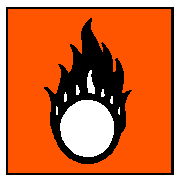International Chemical Safety Cards
| OXYGEN | ICSC: 0880 |
OXYGEN |
 |
| TYPES OF HAZARD/ EXPOSURE |
ACUTE HAZARDS/ SYMPTOMS |
PREVENTION | FIRST AID/ FIRE FIGHTING |
| FIRE | Not combustible but enhances
combustion of other substances. Many reactions may cause fire or explosion. Heating will
cause rise in pressure with risk of bursting. |
NO open flames, NO sparks, and
NO smoking. NO contact with flammable substances. NO contact with fuels and other
combustible materials. |
In case of fire in the
surroundings: all extinguishing agents allowed. |
| EXPLOSION | Risk of fire and explosion on
contact with combustuble materials such as oils or fats. |
|
In case of fire: keep cylinder
cool by spraying with water. Combat fire from a sheltered position. |
| EXPOSURE | |
|
|
| INHALATION | Burning sensation. |
|
Fresh air, rest. Refer for
medical attention. |
| SKIN | Pain. Serious frostbite. ON
CONTACT WITH LIQUID: FROSTBITE. |
Cold-insulating gloves.
Protective clothing. |
ON FROSTBITE: rinse with plenty
of water, do NOT remove clothes. Refer for medical attention. |
| EYES | Redness. Pain. Severe deep
burns. |
Safety goggles, face shield. |
First rinse with plenty of water
for several minutes (remove contact lenses if easily possible), then take to a doctor. |
| INGESTION | |
|
|
| SPILLAGE DISPOSAL | STORAGE | PACKAGING & LABELLING | ||
| Evacuate danger area! Consult an
expert! Ventilation. Do NOT absorb in saw-dust or other combustible absorbents. NEVER
direct water jet on liquid. |
Fireproof. Separated from
combustible and reducing substances. Cool. |
Special insulated cylinder. O symbol R: 8-34 S: 21 UN Hazard Class: 2.2 |
||
| SEE IMPORTANT INFORMATION ON BACK | ||||
|
||||